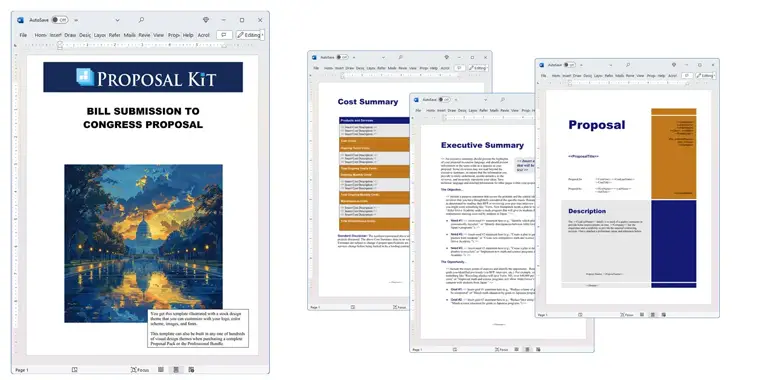How to write your Bill Submission to Congress Proposal
We include this 11 page layout with every Proposal Pack. If you want this template to have a different visual design theme than the one illustrated here, purchase any Proposal Pack design and create this template using the purchased design theme. This template is included in every Proposal Pack. If you get a Proposal Pack or the Professional, you can also make any variation of this template with different chapters to suit your needs.
We typically include more chapters in the templates than most people will need to give everyone more variety in the chapters they may need. You can trim down a long template by removing pages you do not need or combining multiple chapter topics into one page.
 DOWNLOADABLE, ONE-TIME COST, NO SUBSCRIPTION FEES
DOWNLOADABLE, ONE-TIME COST, NO SUBSCRIPTION FEESYou can also create countless variations of this document to suit your needs using the included library of 2200+ chapters if ordering a Proposal Pack or Professional.
 What Our Clients Say
What Our Clients SayStarted using the product last year and it has been an unqualified success. We were able to submit 13 funding proposals for capital projects and all 13 applications were successful. It might be argued that the product was too helpful!"
St Stephen’s Community House
Related Article
Related Video
Related Templates
- Political Lobbying and Consulting Services Proposal
- Political Action Proposal
- Political Campaign Funding Request Proposal
Navigating Bill Submissions to Congress with Proposal Kit
In the complex landscape of legislative processes, drafting a bill for submission to Congress is a meticulous task, especially for those unfamiliar with the nuances of proposal writing. The Proposal Kit, with its extensive template library and Wizard software program, emerges as a powerful tool in this arena, offering clarity and structure to both seasoned professionals and novices alike.
Writing an Effective Congressional Bill Submission
The most effective approach to writing a bill submission to Congress involves a clear structure and detailed content. For beginners, the Proposal Kit provides a robust framework, guiding users through each essential component of the proposal. This includes everything from the preamble (introduction) and needs assessment to detailed bill information and implementation schedules. The software also incorporates a line item quoting database system, which is crucial for accurately presenting costs summaries, quotes, estimates, budgets, and other financial aspects of the bill.
What Types of Projects Are Bill Submission to Congress Proposals Written For?
Various types of projects necessitate congressional bill submissions. Common examples include:
- Proposals for new environmental regulations.
- Bills advocating for changes in healthcare policy.
- Legislative initiatives for education reform.
- Bills focused on technology and data privacy laws.
- Proposals for infrastructure development and funding.
- Legislative efforts for tax reform.
- Bills concerning national security measures.
- Proposals related to immigration policies.
- Legislative initiatives for labor and employment laws.
- Bills addressing social welfare programs.
Chapters this template is built with
The Proposal Kit's templates effectively address various sections of a congressional bill submission.
Incorporating these elements into a bill submitted to Congress ensures a comprehensive, clear, and convincing proposal. Each section plays a vital role in explaining the bill's purpose, backing it with evidence, and outlining a clear path for its implementation and impact.
Cover Letter
This section serves as the first impression of the bill. It should succinctly introduce the bill, highlighting its significance and relevance to current issues. The cover letter must grab the attention of congressional members, compelling them to consider the bill's importance. It sets the tone for the proposal and should reflect the seriousness and urgency of the bill.
Introduction
The introduction provides essential background information. It lays out the context in which the bill has been proposed, its overarching goals, and its relevance to national or societal issues. This section should clearly articulate the purpose of the bill, setting a foundation for the detailed arguments that follow.
Needs Assessment
A critical component, the needs assessment identifies and elaborates on the specific issues or problems the bill aims to address. It should provide a clear understanding of the current situation and the gaps or challenges that the bill intends to tackle. This section establishes the necessity of the bill.
Approval
This section outlines the legislative process required for the bill to become law. It details the steps for gaining approval from various congressional committees, the requirements for majority support, and any other legislative criteria essential for the bill's passage. Understanding this process is crucial for writing a bill that is feasible within the legislative framework.
Implementation Schedule
The implementation schedule provides a timeline for the bill's enactment and execution. It includes key milestones and deadlines, ensuring that the bill's objectives are achieved efficiently and effectively. This schedule helps legislators understand the timeline of the proposed changes and how they will be integrated into existing systems or policies.
Recommendations
Recommendations are actionable steps suggested for the bill's implementation. They provide practical solutions and strategies for achieving the bill's objectives. This section is where specific actions, resources needed, and parties responsible for various aspects of the bill are detailed.
Conclusions
The conclusion summarizes the proposal's main arguments and desired outcomes. It reinforces the significance of the bill and its potential impact. This section should leave a lasting impression, summarizing why the bill is crucial and deserves attention and action.
Findings
This is where research and data supporting the bill are presented. Findings should include statistics, studies, expert opinions, and other relevant data that substantiate the bill's purpose and needs. Solid evidence in this section strengthens the bill's credibility and persuasiveness.
Constituency
Identifying the groups or individuals who will benefit from the bill is crucial. This section outlines who the bill will impact and how, highlighting the positive changes it will bring to these constituencies. It personalizes the bill, making its importance and impact more tangible to legislators.
Definitions
Any technical terms, industry jargon, or specific phrases used in the bill are clarified here. This ensures that all readers, regardless of their background knowledge, have a clear understanding of the proposal's content. Definitions are key to avoiding misunderstandings and ensuring that the bill's language is accessible and precise.
Use cases for this template
Sam's Tech Regulation Initiative
Sam, deeply versed in the complexities of the tech industry, recognized a significant gap in existing digital privacy regulations. With rapid technological advancements, consumer data vulnerabilities had become a pressing concern. He envisioned a bill that would not only address these gaps but also set a precedent for future tech regulations.
Using Proposal Kit, Sam started with a cover letter that succinctly outlined the urgency and importance of his bill. He knew the key to success was in catching the attention of congressional members right from the beginning. In the needs assessment section, Sam detailed the current landscape of digital privacy, using recent data breaches as case studies. The findings section was rich with research, including statistics on data misuse and expert opinions supporting the need for updated regulations.
The implementation schedule Sam proposed was both realistic and forward-thinking, suggesting phased rollouts of the regulations to allow for industry adaptation. His recommendations were strategic, covering not only the immediate steps but also long-term considerations, such as the establishment of a tech oversight committee. Sam's thorough and well-structured proposal, enhanced by Proposal Kit's clarity and organization, laid a strong foundation for legislative consideration.
Ava's Healthcare Deadline
Ava's challenge was not just the complexity of the healthcare bill but also the tight timeframe in which she had to work. Her bill aimed to tackle the critical issue of healthcare accessibility, particularly for underserved communities. With Proposal Kit, she was able to quickly organize her thoughts and data into a coherent structure.
Her introduction painted a vivid picture of the current state of healthcare access, pulling in recent statistics on uninsured populations and the consequences of inadequate healthcare provision. The cost summary was meticulously prepared, outlining the budget required for expanded services and the potential for long-term healthcare savings. Ava's benefits section tied the financial aspects to societal impacts, emphasizing improved community health and productivity as key outcomes.
Despite the looming deadline, Ava's proposal was comprehensive and persuasive. The clear, concise structure provided by Proposal Kit allowed her to present a strong case to her superiors and, ultimately, to Congress, contributing to a positive reception and serious consideration of her bill.
Lucas's Environmental Mission
Lucas, passionate about environmental conservation, embarked on a mission to protect endangered habitats through legislative action. His goal was to submit a bill that would not only bring immediate protection to these habitats but also ensure long-term sustainability. Proposal Kit was instrumental in translating his passion into a compelling legislative proposal.
In his proposal, Lucas used the constituency section to bring the bill's impacts to life, describing the diverse species and ecosystems that would benefit from habitat protection. He included personal stories from local communities that relied on these habitats, adding an emotional appeal to the data-driven narrative.
Lucas's recommendations were practical and actionable, including specific measures for habitat protection and community involvement in conservation efforts. The implementation schedule he proposed was detailed, outlining short-term actions for immediate habitat protection and long-term strategies for sustainable conservation.
His proposal, enhanced by the clear and organized structure of Proposal Kit, effectively communicated the critical need for habitat protection. It resonated with the non-profit's mission and laid a persuasive foundation for legislative action, reflecting Lucas's dedication and the potential for significant environmental impact.
Conclusions and Recommendations
In each scenario, the Proposal Kit proved instrumental in navigating the complexities of drafting a bill submission to Congress. From Sam's tech regulation bill and Ava's healthcare initiative to Lucas's environmental protection effort, Proposal Kit provided a structured, efficient, and comprehensive approach to proposal writing. Each story highlights the versatility of Proposal Kit in addressing a wide range of legislative needs, demonstrating its effectiveness as a tool for creating clear, persuasive, and impactful congressional bill submissions.
The use of Proposal Kit in these varied contexts underscores its utility in solving proposal writing challenges, making it an invaluable resource for anyone looking to make a significant legislative impact. Whether you are a lobbyist, a corporate employee, or a non-profit volunteer, Proposal Kit streamlines the process of drafting a bill submission to Congress, turning complex ideas into coherent, persuasive proposals.
Also Known As
This template may also be referred to in different ways or be used in more specialized situations, such as:
- Legislative Proposal Introduction
- Congressional Measure Filing
- Draft Legislation Presentation
- Bill Proposal Lodgment
- Act Submission to Legislative Body
- Legislative Bill Proposition
- Statute Proposal Submission
- Government Bill Introduction
- Legislative Initiative Filing
- Proposal for Enactment Submission
Abstract
 Creating a bill for submission to Congress requires navigating a complex legislative landscape. Proposal Kit offers an invaluable resource for both seasoned professionals and newcomers, providing the tools necessary for writing persuasive congressional proposals. This software streamlines the process, guiding users through important sections of a bill, such as the cover letter, needs assessment, and implementation schedule, ensuring compliance with existing law and legislative frameworks. By using the Proposal Kit, users can present bills in both the House and Senate in an identical form, enhancing the chances of approval and passage.
Creating a bill for submission to Congress requires navigating a complex legislative landscape. Proposal Kit offers an invaluable resource for both seasoned professionals and newcomers, providing the tools necessary for writing persuasive congressional proposals. This software streamlines the process, guiding users through important sections of a bill, such as the cover letter, needs assessment, and implementation schedule, ensuring compliance with existing law and legislative frameworks. By using the Proposal Kit, users can present bills in both the House and Senate in an identical form, enhancing the chances of approval and passage.
Each successful bill submission to Congress begins with a thorough introduction, setting the stage for the debate and vote in both chambers. Joint resolutions, concurrent resolutions, and simple resolutions are created to address pressing issues, from healthcare reform to environmental regulations. Proposal Kit aids in writing these documents, ensuring that each bill complies with the legislative process where amendments and Senate amendments might be needed. The tool assists in tracking the bill number through its legislative journey, from introduction to potentially facing the president's desk for signing or a veto decision.
The Proposal Kit templates and Wizard software provide crucial support in preparing committee reports, offering a clear path through the divided structures of legislative bodies. Creating recommendations and conclusions, the Proposal Kit helps ensure each proposal resonates with congressional members and aligns with constitutional requirements. The tool is instrumental in navigating the intricacies of private and public legislative processes, enhancing the proposal's impact. From the first step of submitting the bill to tracking its progress through both houses, Proposal Kit manages the intricacies of legislative writing, making complex processes accessible and manageable.
 Navigating the legislative process in Congress requires a methodical approach, especially when writing a bill with the potential to impact both the House and Senate. Proposal Kit emerges as an important tool in this endeavor, offering templates and guidance that ensure each proposal is presented in an identical form across chambers, an important factor in the bill's success. This resource aids in writing joint resolutions, concurrent resolutions, and simple resolutions, each designed to address significant national issues, from healthcare and education reform to infrastructure development and national security measures.
Navigating the legislative process in Congress requires a methodical approach, especially when writing a bill with the potential to impact both the House and Senate. Proposal Kit emerges as an important tool in this endeavor, offering templates and guidance that ensure each proposal is presented in an identical form across chambers, an important factor in the bill's success. This resource aids in writing joint resolutions, concurrent resolutions, and simple resolutions, each designed to address significant national issues, from healthcare and education reform to infrastructure development and national security measures.
A key topic of the Proposal Kit is its ability to assist users in understanding and adhering to existing laws while creating new legislative initiatives. The software provides a comprehensive framework that includes necessary components such as the constitutionally required enacting clauses, definitions to clarify technical language, and a detailed needs assessment that identifies the problems the bill seeks to address. Furthermore, the Proposal Kit helps users prepare a robust committee report, a vital document that outlines the bill's purpose and legislative intent, facilitating smoother passage through committee stages.
As users introduce their proposals, the Proposal Kit also offers tools to track the bill's progress, monitor any Senate amendments, and adjust strategies accordingly. It ensures that each proposal aligns with constitutional requirements and legislative priorities, making it easier to gain the support needed for a successful vote. The tool encourages proactive engagement, helping users manage the debate within legislative sessions and prepare for any potential pocket veto or presidential veto situations.
 In addition, the Proposal Kit aids in assigning roles and responsibilities, ensuring that each member involved in the proposal process understands their tasks. The tool's comprehensive database supports the preparation of financial summaries, estimates, and budgets, which are critical for gaining approval from legislative bodies. It also assists in the preparation of documents for publication, ensuring that each proposal is properly recorded and accessible to the public.
In addition, the Proposal Kit aids in assigning roles and responsibilities, ensuring that each member involved in the proposal process understands their tasks. The tool's comprehensive database supports the preparation of financial summaries, estimates, and budgets, which are critical for gaining approval from legislative bodies. It also assists in the preparation of documents for publication, ensuring that each proposal is properly recorded and accessible to the public.
By offering a structured approach to writing and submitting bills and customizable software features and templates, Proposal Kit ensures that each legislative initiative is clear, convincing, and capable of making a significant impact. Whether addressing social welfare programs, labor laws, or immigration policy, the Proposal Kit provides the clarity and organization necessary for navigating the first step of legislative submission through to final approval and enactment. Its utility in solving proposal writing challenges makes it an invaluable resource for lobbyists, corporate representatives, and non-profit volunteers alike, ensuring that each proposal is positioned for success in Congress.
These features and capabilites are addressed by using the software customizability feature such as custom tracking, customizable templates to allow for users to input their own text that covers any legislative requirements and features already built into Microsoft Office.
Frequently Asked Questions
What is the proper format for writing a bill submission to Congress?
The proper format for writing a bill submission to Congress includes several key components: the title, enacting clause, purpose, definitions, provisions, and effective date. The title should be concise and descriptive, indicating the bill's primary objective. The enacting clause typically reads, Be it enacted by the Senate and House of Representatives of the United States of America in Congress assembled. The purpose section outlines the bill's intent, while the definitions section clarifies any specific terms used. The provisions detail the actions, changes, or regulations proposed, and the effective date specifies when the bill would go into effect if passed.
How do I ensure my bill addresses a significant issue?
To ensure your bill addresses a significant issue, conduct thorough research to identify pressing problems that require legislative action. Gather data, statistics, and expert opinions to support the need for the bill. Engage with stakeholders, including community groups, advocacy organizations, and experts in the field, to understand the breadth and depth of the issue. By demonstrating that the issue has a broad impact and presenting well-researched evidence, you can make a case for the importance of your bill.
What resources are available to help me draft my bill?
Several resources are available to help draft your bill, including the Congressional Research Service (CRS), which provides non-partisan support and research to Congress members. Legal experts and legislative aides can also guide legal language and structure. Online templates and guides from reputable sources, such as the Library of Congress or academic institutions, can provide helpful frameworks. Additionally, studying existing bills with similar objectives can offer insight into effective drafting techniques.
How can I gain support for my bill from members of Congress?
Gaining support for your bill involves communication and relationship-building. Begin by identifying members of Congress who have shown interest in related issues and arranging meetings to present your proposal. Prepare a pitch that highlights the benefits and urgency of the bill. To demonstrate broad support, garner endorsements from influential organizations, community leaders, and constituents. Providing clear, concise, and persuasive materials, such as fact sheets and testimonies, can also help convince members of Congress to back your bill.
What steps should I take after submitting my bill to Congress?
After submitting your bill, it is crucial to engage in active advocacy to move it through the legislative process. Monitor the bill's progress and stay informed about committee assignments and hearing dates. Continue to build and maintain support by meeting with legislators, testifying at hearings, and mobilizing grassroots efforts to generate public and media attention. Collaborate with allies to address any potential opposition and make necessary amendments to gain broader support. Persistence and proactive engagement are key to navigating the complexities of the legislative process and advancing your bill toward enactment.
20% Off Discount
![]() Add To Cart This Word Template
Add To Cart This Word Template
 Add To Cart Proposal Pack for Any Business
Add To Cart Proposal Pack for Any Business
 Add To Cart Proposal Kit Professional
Add To Cart Proposal Kit Professional
 4.7 stars, based on 849 reviews
4.7 stars, based on 849 reviewsProposal Kit chapters used in this template
Cover Letter, Introduction, Needs Assessment, Findings, Constituency, Approval, Conclusions, Recommendations, Implementation Schedule, Definitions, Back Page
Line Item Automated Chapters
If you purchase a Proposal Pack or the Professional Bundle, these proposal pages are generated using an automated line-item database in the included Wizard software.
Implementation Schedule
You use this proposal for
- Non-technical proposal
How to create this template with Proposal Pack Wizard
You can create this document using any of the logo-designed Proposal Packs. Pick any Proposal Pack with a logo design theme you like best; they will all work equally well. The Proposal Pack for Any Business is the pack with no extra added logos or colors - designed to be used plain or for you to customize with your logos and graphics.
The Proposal Pack design theme you purchase will determine the visual look of this template. The screenshot above only shows the plain generic design theme.
We include a library of chapters to be assembled based on your needs. All proposals are different and have different needs and goals. We designed Proposal Pack so you can customize the documents to suit your needs.
You will best create this document using the Proposal Pack Wizard - Expert Edition software to select this template and build it in the Proposal Pack logo design theme of your choice along with any desired customizations (such as adding additional chapters, removing unneeded chapters, changing the order of chapters, and importing your company logo). This template outlines a proposal for the described situation. Each user is responsible for typing in the actual content of the provided pages with their information to complete the proposal. Suggestions in the abstract may include features in higher-end packages and are facilitated by the selection of chapter templates to support the narrative of each proposal, which help guide the user in filling in the details.
The Wizard software's AI Writer will write the content of the pages of the template based on details provided for your company, client, project, financial details and other writing instructions. This will provide a personalized version of the template completely written and ready to edit.
Once finished, the AI Writer's Word-to-PowerPoint converter can transform your proposal, business plan, or other business documents into a PowerPoint slideshow. Save time and effort by letting the AI analyze every chapter to condense its content into talking points, visually matching the document, and providing a consistent package of presentation material with the click of a button.
You create this template using the Wizard software with an entire Proposal Pack library and software. We include the Expert Edition of the software in the Proposal Kit Professional. Microsoft Word for Windows is required to use the customizing software. You can also edit Word document templates in other office software such as Word for Mac. We will assist Mac users in assembling complex templates for their first project if they do not have the required platform to run the Wizard software.
How to Build Templates Featured on Proposal Kit Website
Many people find the Proposal Kit website after searching for a specific proposal. Once you've purchased and installed the software, how do you build that template you found in the first place? This video shows you how to build any proposal you see on the Proposal Kit website.
 Ian Lauder has been helping businesses write their proposals and contracts for two decades. Ian is the owner and founder of Proposal Kit, one of the original sources of business proposal and contract software products started in 1997.
Ian Lauder has been helping businesses write their proposals and contracts for two decades. Ian is the owner and founder of Proposal Kit, one of the original sources of business proposal and contract software products started in 1997.By Ian Lauder
 Published by Proposal Kit, Inc.
Published by Proposal Kit, Inc.


 Cart
Cart
 Get 20% off ordering today:
Get 20% off ordering today: 


 Facebook
Facebook YouTube
YouTube Bluesky
Bluesky Search Site
Search Site